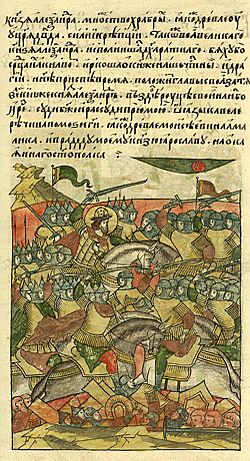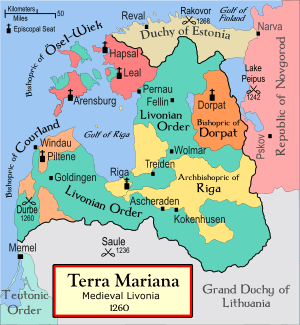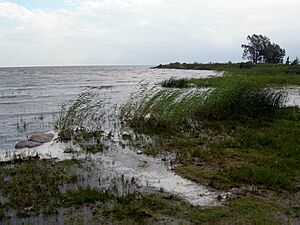Battle on the Ice facts for kids
Quick facts for kids Battle on the Ice |
|||||||||
|---|---|---|---|---|---|---|---|---|---|
| Part of the Northern Crusades and the Livonian campaign against Rus' | |||||||||
 Depiction of the battle in the late 16th century illuminated manuscript Life of Alexander Nevsky |
|||||||||
|
|||||||||
| Belligerents | |||||||||
|
Livonian Order |
Novgorod Republic
|
||||||||
| Commanders and leaders | |||||||||
| Hermann of Dorpat Andreas von Velven |
Alexander Nevsky Andrey Yaroslavich |
||||||||
| Strength | |||||||||
|
1,800:
|
6,000–7,000:
|
||||||||
| Casualties and losses | |||||||||
| Livonian Rhymed Chronicle: 20 knights killed 6 knights captured Novgorod First Chronicle: 400 Germans killed 50 Germans imprisoned "Countless" Estonians killed |
No exact figures | ||||||||
The Battle on the Ice, also known as the Battle of Lake Peipus, happened on April 5, 1242. It was fought mostly on the frozen Lake Peipus. This lake is located between what is now Estonia and Russia.
The battle was between the forces of the Novgorod Republic and Vladimir-Suzdal, led by Prince Alexander Nevsky. They fought against the Livonian Order and the Bishopric of Dorpat, led by Bishop Hermann of Dorpat.
This battle was very important. Its outcome decided if Western Catholicism or Eastern Orthodox Christianity would be stronger in the region. The Catholic forces lost badly during the Northern Crusades. This defeat stopped their campaigns against the Orthodox Novgorod Republic and other Russian lands for the next 100 years.
Over time, Russian stories made the battle seem even bigger and more important. They called it one of the greatest Russian victories of the Middle Ages. A famous movie from 1938, Alexander Nevsky, showed the battle. This film created a popular but not always accurate picture of what happened. Today, the Novgorodian victory is remembered in Russia as one of their Days of Military Honour.
Contents
Why the Battle Happened: Background History

In the early 1200s, the Pope in Rome wanted to spread Christianity in the Baltic region. This led to what were called the Northern Crusades. Different groups like the Swedes, Danes, and German knights (Teutonic Knights and Livonian Order) joined these crusades.
One goal was to convert people in areas like Finland and Livonia. However, this caused problems with the Novgorod Republic. Novgorod was a powerful Russian state that already had influence and trade in these areas. For example, the Karelians, who lived near Finland, were allies of Novgorod.
In 1240, Swedish forces attacked the Neva River area. They were stopped by a Novgorodian army led by Prince Alexander Nevsky. Alexander won this fight, called the Battle of the Neva, and earned his famous nickname Nevsky. Novgorod fought to protect its fur trade and economic interests.
At the same time, the Livonian Order and other crusaders were active in Estonia. Novgorod had also tried to control and convert the pagan Estonians. Sometimes, Estonians even allied with Russian princes against the crusaders. This showed that the crusades threatened Russian interests.
In late 1240, the Teutonic Knights attacked the Novgorod Republic. They took over cities like Pskov, Izborsk, and Koporye. Novgorod was having internal problems at the time, which the knights hoped to use to their advantage. When the knights got close to Novgorod itself, the people called back Prince Alexander Nevsky. He had been sent away earlier that year.
In 1241, Alexander Nevsky led a campaign to take back the captured cities. He successfully recaptured Pskov and Koporye from the crusaders. He even punished local people who had helped the invaders. Alexander then moved into Estonian-German territory.
In the spring of 1242, a small part of Alexander's army was defeated by the Teutonic Knights. This happened about 20 kilometers south of Dorpat (modern Tartu). Because of this, Alexander chose a strong position on Lake Peipus.
The knights and their local allies, the Ugaunians, met Alexander's forces on April 5, 1242. The battle took place on the narrow strait (Lake Lämmijärv) that connects the two main parts of Lake Peipus.
The Battle on the Ice
On April 5, 1242, Alexander Nevsky wanted to fight on ground he chose. He pulled his forces back to draw the crusaders onto the frozen lake. The crusaders were often very confident, and Alexander used this to his advantage.
Historians have different ideas about how many soldiers were in each army. A careful guess suggests the crusader forces had about 2,600 men. This included 800 Danish and German knights, 100 Teutonic knights, 300 Danes, 400 Germans, and 1,000 Estonian foot soldiers.
The Russian forces had around 5,000 men. This included Alexander and his brother Andrei's bodyguards (about 1,000). There were also 2,000 militia from Novgorod, 1,400 Finno-Ugrian tribesmen, and 600 horse archers.
The Teutonic knights and crusaders charged across the lake. They reached the enemy but were slowed down by the Novgorod foot soldiers. This made their powerful attack lose its speed. The fighting was very fierce, with both sides battling on the slippery ice.
After about two hours of close fighting, Alexander ordered his army's left and right sides to attack. These wings included cavalry (soldiers on horseback). By this time, the Teutonic and crusader troops were tired from fighting on the ice. The crusaders began to retreat in a messy way deeper onto the ice. When the fresh Novgorod cavalry appeared, they panicked and fled.
It's a popular story that the ice broke under the heavy armor of the knights, and many drowned. However, many historians say this part of the story is not true. It seems this idea first appeared in the 1938 film Alexander Nevsky. Earlier historical accounts of the battle do not mention the ice breaking or knights drowning.
Who Won? Casualties and Losses
The Livonian Rhymed Chronicle, written in the late 1340s, describes the losses for the crusaders:
- "The [Russians] had many archers."
- "The battle began with their bold assault on the king's men [Danes]."
- "The brothers' banners were soon flying in the midst of the archers."
- "Swords were heard cutting helmets apart."
- "Many from both sides fell dead on the grass."
- "Then the Brothers' army was completely surrounded."
- "There were easily sixty men for every one German knight."
- "The Brothers fought well enough, but they were nonetheless cut down."
- "Some of those from Dorpat escaped from the battle."
- "Twenty brothers lay dead and six were captured."
The Novgorod First Chronicle gives different numbers for the losses:
- "Prince Alexander and all the men of Novgorod drew up their forces by the lake."
- "The Germans and the Estonians rode at them, driving themselves like a wedge."
- "There was a great slaughter of Germans and Estonians."
- "They fought with them during the pursuit on the ice for seven versts." (A verst is an old Russian unit of distance, about 1.06 kilometers or 0.66 miles).
- "A countless number of Estonians fell."
- "400 of the Germans fell."
- "Fifty Germans were captured and taken to Novgorod."
What Happened Next: Historical Legacy
The Battle on the Ice was very important because it stopped the Teutonic Order from expanding eastward. It created a lasting border along the Narva River and Lake Peipus. This border separated Eastern Orthodoxy from Western Catholicism.
The knights' defeat meant they could not retake Pskov, which was key to their eastern plans. The Novgorodians successfully defended their land. The crusaders never again launched a major attack eastward. Alexander Nevsky was later made a saint in the Russian Orthodox Church in 1574.
Some historians have debated how important and how big the battle really was. Some argued it was part of a larger plan by the Pope. However, more recent historians disagree. They say there isn't enough proof of a big coordinated attack by all the Western groups. They also point out that papal documents from that time don't mention fighting Russians, but rather non-Christians.
The battle was made famous by Sergei Eisenstein's patriotic film Alexander Nevsky in 1938. The movie showed the Teutonic Knights like Nazi Germans. This film created a popular image of the battle that is often mistaken for the real events. For example, the idea of knights drowning when the ice broke comes from this movie. The composer Sergei Prokofiev also wrote music for the film, including a famous piece called "The Battle on the Ice."
During World War II, Alexander Nevsky became a symbol for Russia fighting against German occupation. The Order of Alexander Nevsky medal was brought back in the Soviet Union in 1942. Since 2010, the Russian government gives out an Order of Alexander Nevsky for bravery and service to the country.
In 1983, a historian named John L. I. Fennell suggested the battle wasn't as big or important as often thought. He said most Teutonic Knights were fighting elsewhere. He also noted that the low number of knight casualties in their own records suggested a small fight. He also said that some old Russian and Swedish records didn't even mention the battle. This, he argued, meant it was just one of many small clashes.
However, another Russian historian, Alexander Uzhankov, disagreed. He said Fennell ignored many facts. Uzhankov pointed to two papal documents from 1233 and 1237 that called for a crusade against non-Christians, with the first one mentioning Russia. He also noted that Sweden, Denmark, and the Teutonic Order formed a large alliance in 1238. Uzhankov also highlighted a 1243 treaty where the knights gave up all claims to Russian lands. He argued that for every knight, there were many other soldiers, like squires and archers, making the battle larger than Fennell suggested.
Images for kids




